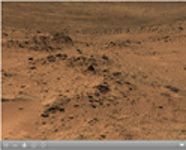
'Everest' Panorama 20-20 Vision (QTVR)
'Everest' Panorama AnimationIf a human with perfect vision donned a spacesuit and stepped onto the martian surface, the view would be as clear as this sweeping panorama taken by NASA's Mars Exploration Rover Spirit. That's because the rover's panoramic camera has the equivalent of 20-20 vision. Earthlings can take a virtual tour of the scenery by zooming in on their computer screens many times to get a closer look at, say, a rock outcrop or a sand drift, without losing any detail. This level of clarity is unequaled in the history of Mars exploration.
It took Spirit three days, sols 620 to 622 (Oct. 1 to Oct. 3, 2005), to acquire all the images combined into this mosaic, called the "Everest Panorama," looking outward in every direction from the true summit of "Husband Hill." During that period, the sky changed in color and brightness due to atmospheric dust variations, as shown in contrasting sections of this mosaic. Haze occasionally obscured the view of the hills on the distant rim of Gusev Crater 80 kilometers (50 miles) away. As dust devils swooped across the horizon in the upper right portion of the panorama, the robotic explorer changed the filters on the camera from red to green to blue, making the dust devils appear red, green, and blue. In reality, the dust devils are similar in color to the reddish-brown soils of Mars. No attempt was made to "smooth" the sky in this mosaic, as has been done in other panoramic-camera mosaics to simulate the view one would get by taking in the landscape all at once. The result is a sweeping vista that allows viewers to observe weather changes on Mars.
The summit of Husband Hill is a broad plateau of rock outcrops and windblown drifts about 100 meters (300 feet) higher than the surrounding plains of Gusev Crater. In the distance, near the center of the mosaic, is the "South Basin," the destination for the downhill travel Spirit began after exploring the summit region.
This panorama spans 360 degrees and consists of images obtained during 81 individual pointings of the panoramic camera. Four filters were used at each pointing. Images through three of the filters, for wavelengths of 750 nanometers, 530 nanometers and 430 nanometers, were combined for this approximately true-color rendering.

 Planetary Data System
Planetary Data System














